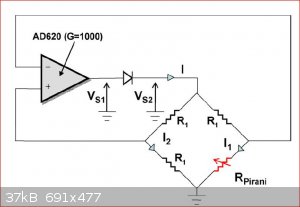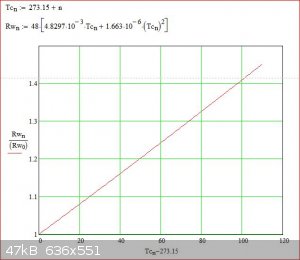wg48temp9
National Hazard
   
Posts: 761
Registered: 30-12-2018
Location: not so United Kingdom
Member Is Offline
|
|
DIY Pirani vacuum pressure gauge electronics
My four faulty Inficon BPG40X Bayard-Alpert Pirani combination gauges arrived today. They all have two identical filaments and they appear intact.
The connector contains some electronics that may be faulty or perhaps the filaments are contaminated and out of spec. That should not be a problem
for me.
So I have to make a circuit to use one. I assume I have to use one of the coated filament of the Bayard-Alpert gauge as a Pirani gauge. Apparently
modern Pirani gauges operate with a fixed temperature of the filament with a control system that varies the heating current/voltage to keep the
temperature constant. Below is a typical control circuit.

It took me a while to work out how the circuit worked as it looks like it has both positive and negative feed back.
The op amp compares the voltage of one half the bridge with the other half then change the drive voltage to the bridge to make them equal. As the
drive voltage to the bridge changes, the power dissipated in the filament changes which changes its temperature and therefore its resistance.
The drive voltage is then a function of the heat loss of the filament which is a function of the gas pressure in the gauge head. I assume R1 is
arranged to have a greater resistance than the filament when its cold. I suspect the bandwidth of the opamp has to be less than the thermal time
constant of the filament for stability of the control loop. It probably needs an integral term to reduce the error to that of the offset voltage of
the op amp.
Over a wide range of pressures the thermal conductivity of a gas is proportional to its pressure so I will only need one calibration point.
When I get my diffusion pump going I will need the Bayard-Alpert gauge working.
One irritating point is the gauge base is welded to the tube of the KF25 flange so it will not be so easy to just use the base as a vacuum electrical
feed through or replace the filaments.
[Edited on 10/28/2020 by wg48temp9]
I am wg48 but not on my usual pc hence the temp handle.
Thank goodness for Fleming and the fungi.
Old codger' lives matters, wear a mask and help save them.
Be aware of demagoguery, keep your frontal lobes fully engaged.
I don't know who invented mRNA vaccines but they should get a fancy medal and I hope they made a shed load of money from it.
|
|
|
Metallophile
Hazard to Self
 
Posts: 82
Registered: 23-3-2018
Member Is Offline
Mood: No Mood
|
|
Quote: Originally posted by wg48temp9  | As the drive voltage to the bridge changes, the power dissipated in the filament changes which changes its temperature and therefore its resistance.
|
It seems like the filament would need to have a significant R/T slope for this to work well. So probably Nichrome is out? I see that the real ones use
Titanium or Platinum wire. I'd love to try to make one of these things, but I'd need to find a suitable filament.
|
|
|
wg48temp9
National Hazard
   
Posts: 761
Registered: 30-12-2018
Location: not so United Kingdom
Member Is Offline
|
|
Quote: Originally posted by Metallophile  |
It seems like the filament would need to have a significant R/T slope for this to work well. So probably Nichrome is out? I see that the real ones use
Titanium or Platinum wire. I'd love to try to make one of these things, but I'd need to find a suitable filament.
|
Tungsten has a significant R/T slope. About 60% change for 110C increase from RT. So tungsten filaments lamps can be used. You can still buy wire
ended miniature lamps on ebay or 0.1mm tungsten wire. You can also tungsten as a temperature sensor. As a filament in light bulb it will not corrode
and a quartz tungsten type should be good to about 1100C.
The electrical resistivity of tungsten RW in n-ohm·m are given by
RW = 48.0 (1 + 4.8297 × 10-3 T + 1.663 × 10-6 T^2)
[Edited on 10/28/2020 by wg48temp9]

I am wg48 but not on my usual pc hence the temp handle.
Thank goodness for Fleming and the fungi.
Old codger' lives matters, wear a mask and help save them.
Be aware of demagoguery, keep your frontal lobes fully engaged.
I don't know who invented mRNA vaccines but they should get a fancy medal and I hope they made a shed load of money from it.
|
|
|
Metallophile
Hazard to Self
 
Posts: 82
Registered: 23-3-2018
Member Is Offline
Mood: No Mood
|
|
Quote: Originally posted by wg48temp9  |
Tungsten has a significant R/T slope. About 60% change for 110C increase from RT. So tungsten filaments lamps can be used.
|
Excellent! I have a whole drawer full of old but functional incandescent bulbs that I swapped out back in the compact fluorescent era. Looks like a
60W 120V bulb would be about 16 ohms at room temp, which sounds like a reasonable number to start with.
|
|
|
Twospoons
International Hazard
    
Posts: 1282
Registered: 26-7-2004
Location: Middle Earth
Member Is Offline
Mood: A trace of hope...
|
|
I've always wanted to build a pirani or thermistor gauge, but I'm a little stumped by the calibration problem - what do you do if you don't have a
calibrated gauge to test against?
Helicopter: "helico" -> spiral, "pter" -> with wings
|
|
|
wg48temp9
National Hazard
   
Posts: 761
Registered: 30-12-2018
Location: not so United Kingdom
Member Is Offline
|
|
Quote: Originally posted by Twospoons  | I've always wanted to build a pirani or thermistor gauge, but I'm a little stumped by the calibration problem - what do you do if you don't have a
calibrated gauge to test against?
|
You could you the vapour pressure of different liquids to calibrate the gauge or the visual or electrical characteristics of a low pressure
electrical discharge connected to the gauge. Now that not going to be very accurate but if your gauge reading is stable, reproducible and monotonic
you can at least see that the vacuum is getting better or worse as you try to stop leaks. You can also hunt for leaks using a small helium jet. When
the jet is directed at the leak the pressure increases.
I am wg48 but not on my usual pc hence the temp handle.
Thank goodness for Fleming and the fungi.
Old codger' lives matters, wear a mask and help save them.
Be aware of demagoguery, keep your frontal lobes fully engaged.
I don't know who invented mRNA vaccines but they should get a fancy medal and I hope they made a shed load of money from it.
|
|
|